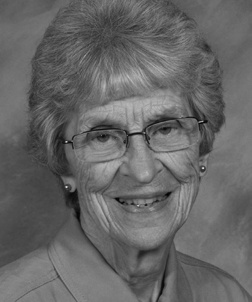MARGARET R. BRENNAN, IHM ’45
 Just a month after marching in cap and gown to receive her diploma from Marygrove College, Margaret R. Brennan walked up the steps of the Motherhouse of the Sisters, Servants of the Immaculate Heart of Mary in Monroe, prepared to earn the distinctive royal blue habit of the order. She entered an environment both austere and protective. Shortly thereafter, Sister Margaret (formerly Benedicta) was sent to St. Mary's College Notre Dame, Indiana, to earn a doctorate at the only institution in the country that allowed women to earn Ph.D.s in theology. During summers she took courses at the University of Notre Dame.
Just a month after marching in cap and gown to receive her diploma from Marygrove College, Margaret R. Brennan walked up the steps of the Motherhouse of the Sisters, Servants of the Immaculate Heart of Mary in Monroe, prepared to earn the distinctive royal blue habit of the order. She entered an environment both austere and protective. Shortly thereafter, Sister Margaret (formerly Benedicta) was sent to St. Mary's College Notre Dame, Indiana, to earn a doctorate at the only institution in the country that allowed women to earn Ph.D.s in theology. During summers she took courses at the University of Notre Dame.
In 2009, 64 years after arriving at the Motherhouse, Margaret R. Brennan, IHM, Ph.D., published her memoir, "What Was There for Me Once." In it she reflects on the many changes in religious life in the United States both before and after the "epoch-making experience of the Second Vatican Council," as well as the parallel changes in her own life as an IHM. She was part of the Sister Formation Movement that took hold during the 1950s. The Sister Formation Movement called for improved sister teacher preparation and the integrated development of women in religious communities. The idea that young sisters complete their degrees before going out to teach (rather than over 17 summers, which was more common at the time) was a hard sell when Catholic schools were deluged with applicants.
Sister Margaret took on a direct role in sister formation when she was named IHM Novice Directress in 1962. Even before Vatican II, Pope Pius XII urged women religious to update their lives in light of the changing culture. Sister writes, "In response to his summons, women religious in the United States began to hold conferences to discuss how they could be a greater force and influence in society." At the General Chapter in June 1966, Sister Margaret was elected General Superior of the IHMs, a post she held for the next decade. Cardinal John Dearden named Sister Margaret to the first Pastoral Council convened in the archdiocese to implement Vatican II. Lay people predominated on the council. It was Sister Margaret's first experience in ministering outside religious life. As General Superior, Sister Margaret oversaw a congregation as far flung as a multi-national corporation. There were IHM sisters in Vietnam to teach orphans that were among those involved in the Baby Lift before the fall of Saigon in 1975. Other sisters took part in a variety of ministries in Brazil, Uganda, Kenya, Ghana, Zimbabwe and South Africa.
So that women's voices, scholarship and experience could be heard in a male-dominated church, Sister Margaret determined that the order should have theologians among its members, unheard of at the time. Ten sisters were sent to diverse institutions to obtain doctorates in theology and canon law. They studied at Louvain, Rome, Paris, Toronto, Notre Dame and elsewhere.
Leadership during the 1960s and 1970s required the negotiating skills of an experienced judge, a seasoned diplomat and a tough union boss. Racial unrest due to the prospect of integration was a problem in some parishes and resulted in the IHM sisters withdrawing from St. Raymond School in Detroit. A move in the Michigan legislature which denied funds to Catholic schools for non-religious programs caused the closure of 40 schools. In response to these changes, sisters sought ministries outside of education. With Sister Margaret's support, and in the spirit of the Vatican Council, IHMs began to protest publicly where they saw injustice.
Sister Margaret was elected president of the Leadership Conference of Women Religious (LCWR) from 1972-73. Though the Conference originally was supported by the Vatican, as it grew in strength it faced greater obstacles from that same source. In fact, it took more than ten years to receive approval of new by-laws. There were many struggles as the LCWR tried to overcome the reality that they were often treated as second-class citizens.
In 1973, with her term completed, Sister Margaret accepted an offer for her sabbatical from the Jesuits to join a pilot program at Regis College, part of the Toronto School of Theology. At the end of the year she was asked to become a member of the Regis faculty in the pastoral program with a focus on the Integration of Ministry Program. She was a professor of theology and director of a spiritual renewal program for the next 25 years until she returned to Michigan. Now retired, Sister Margaret continues to write and accepts speaking engagements here and abroad.
